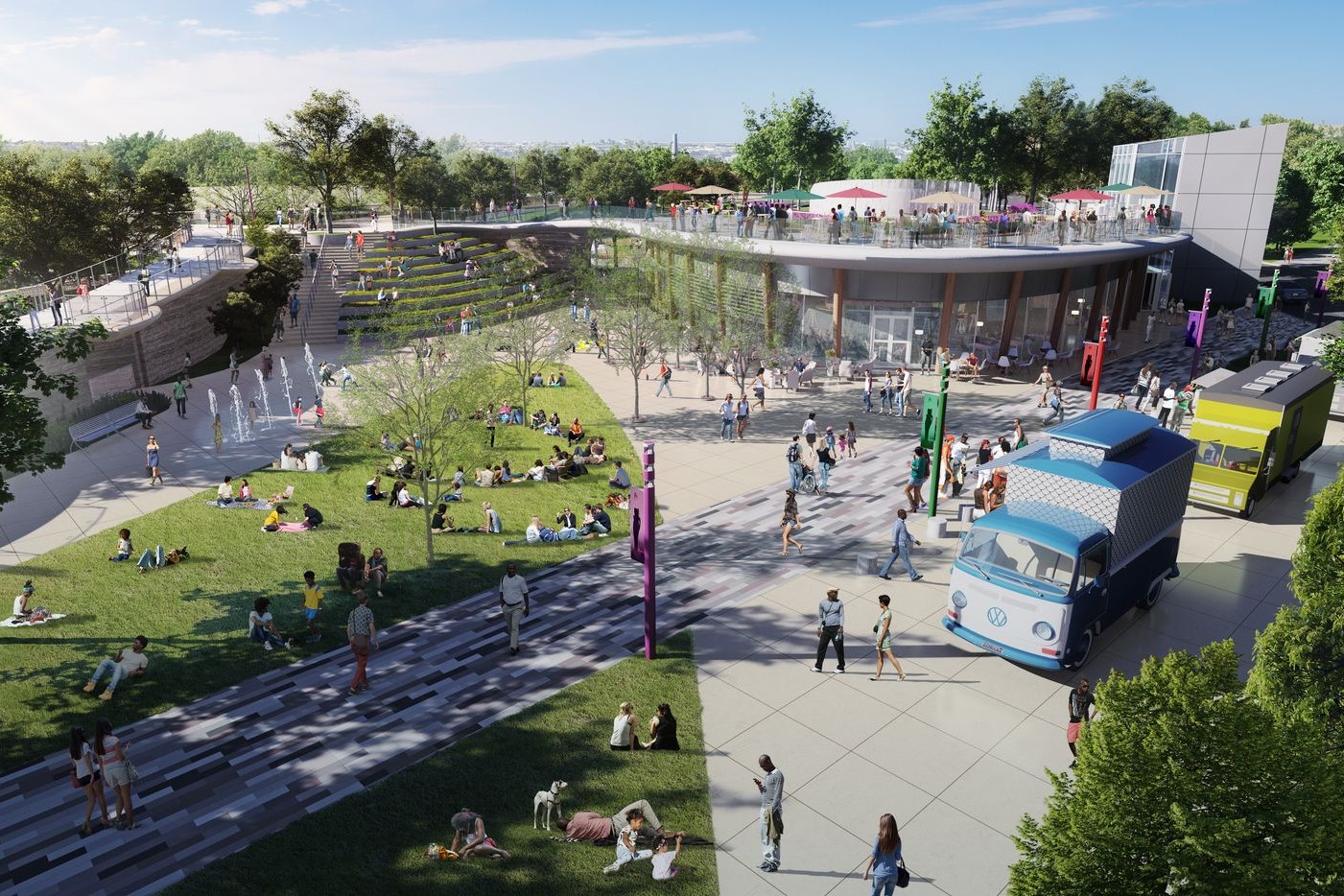In the Dallas Morning News yesterday, columnist Sharon Grigsby writes about the new plans for the I-35E deck park in Oak Cliff. The city’s second deck park is being constructed as part of the massive Southern Gateway project – a rebuild of the interstate highway that tore through some of Dallas’ oldest neighborhoods when it was built back in the 1960s. Like many of Dallas’ recent park projects, the new deck park is being pitched as a way to stitch these communities back together.
Grigsby digs into the new plans for the Southern Gateway Park, which will be constructed in two phases. The first phase set to open at the end of 2023, and the second phase will require some additional fundraising. You can also learn more about the project and see more renderings on its website. But after reading about the new park, I wanted to point out a couple of things that struck me about the project.
The first has to do with community trust. When the deck park was first proposed back in 2017, there was some concern that park wouldn’t deliver on its promise to reunite the Oak Cliff neighborhoods – including the Tenth Street Historic District, one of the last intact freedman’s towns in the nation – but would instead accelerate the process of displacement.
Residents had reason to distrust the project. Their experience with large-scale public infrastructure projects has shown that, historically, Dallas doesn’t improve things in places like East Oak Cliff for the people who live in Oak Cliff. Grigsby mentions Thomas Hill Park, which is one of the city’s oldest parks and a rare stretch of greenspace for the surrounding neighborhoods. The park was repurposed by the city (without much input from the surrounding neighborhoods) 30 years ago to accommodate a zoo expansion.
And so, the challenges facing the new deck park went beyond raising the private funding to construct the project. Backers needed to earn neighborhood buy-in. And it appears they have. The new private organizations created to plan and raise funds for the park are headed by members of the communities around the park, and they have worked to incorporate community feedback into the design of the first phase:
Phase One of this public-private partnership features expansive lawns and the many programming elements that neighbors said were most important: a stage and pavilion, a children’s playground and interactive water features, outdoor classroom space for schools and organizations, a multipurpose building, integrated exhibits in the terraced “history stairs” and a dedicated food truck area.
This process echoes something I wrote about Monday regarding I-345. Successful infrastructure projects can deliver on their potential for improvement by allowing the communities to set expectations for the project. Then, those expectations must be met in the design. In the case of the I-35 deck park, one community expectation was heartbreakingly simply: provide residents a space to walk to.
[Lester] Houston, among the Southern Gateway foundation’s first board members, gets calls weekly about the park, many of them from residents who remember when the city abruptly took the neighborhood’s Thomas Hill Park for a zoo expansion more than 30 years ago.
He relishes getting to respond with a hearty “yes” when those fellow residents ask, “Are you telling me that we’re going to have a place we can walk to?”
There’s something a little disheartening about this anecdote. It shows how low the bar of expectation is for many people in Dallas, and particularly those living in southern neighborhoods. For generations, there was little expectation that public investment would deliver basic amenities to their communities. But the deck park project suggests that things are changing – that the city has finally learned that it can deliver the best results for its residents by first listening to them.
It’s part of what gives Lester Houston hope in his hometown. Houston is another revelation in Grigsby’s piece. His personal story offers a microcosm of a particular experience of this city’s history. Born in the State-Thomas neighborhood before the historic Black community was erased by the growth of Uptown, Houston’s family moved to Oak Cliff when he was 4 years old. He graduated from Roosevelt High School, served in the Marines, and escaped Dallas to successful careers in New York, Los Angeles, Atlanta, and Washington D.C.
But then Houston returned to Dallas, drawn back to his hometown by a nostalgia for a sense of pride and community he remembered growing up in Oak Cliff. When he heard about the deck park project, he wanted to get involved. Former Councilman Scott Griggs was eager to recruit him to the park project’s board:
Houston loves the park’s design, which he believes is “genuine Oak Cliff,” and he credits the architects with taking a “bottom-up approach that involved people early in the game.”
He believes the community involvement has eased early concerns — that the park would bring gentrification with it or that funders wouldn’t support a project south of I-30.
“People are looking for progress in their neighborhoods, especially people who have lived here for decades,” he said. “And they think this park will give that for a change.”
Houston said he even had to confess to something that his younger self would never have believed possible: “I’m so proud of Dallas. Dallas is actually changing, I’m seeing progress.”





